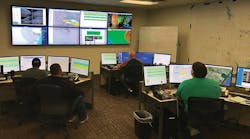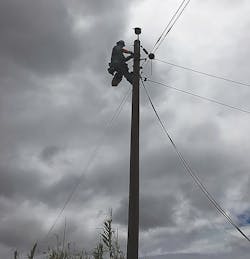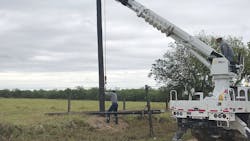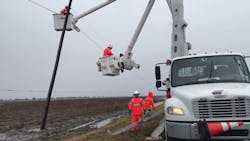Late in the evening of Friday, Aug. 25, 2017, Hurricane Harvey hit the Texas Gulf Coast as a Category 4 storm with winds up to 130 mph (209 kmph). Nueces Electric Cooperative (NEC), the only deregulated electric co-op in Texas and only one of a handful in the U.S., reported that 45% of its customers had lost power, leaving 8200 homes and businesses in the dark. Storm damage included the loss of 24 poles, eight substation feeders and one entire substation.
While it took some utilities in Harvey’s damage area days and even weeks to restore power, NEC had an upper hand. Thanks to a comprehensive emergency response plan, quick mobilization of staff and the latest technology, NEC restored power for approximately 95% of its members in Corpus Christi and surrounding areas within 24 hours. Power was completely restored to 100% of the membership within 48 hours. Most members who had evacuated the area already had their power back on by the time they returned home.
Accomplishing this rapid restoration of services required significant planning, optimal execution from field staff and the right technology. This is about how these pieces came together to achieve a successful restoration following a deadly storm.
Building the Recipe
After a natural disaster, all eyes focus on repairing infrastructure and rapidly restoring essential services, which can be a matter of life or death. Mother Nature poses an ongoing threat to electrical infrastructures, so it is vital that utilities have a resilient communication network to navigate the rebuilding process. The quality of the communications technology that utilities select determines whether their data will be transmitted efficiently, securely and reliably over the long haul. It is not a decision to take lightly.
NEC chose to leverage an advanced metering infrastructure (AMI) solution from Sensus anchored by the FlexNet Communication Network, a two-way communication network that serves as the utility’s access point to system status before, during and after an event like Harvey, helping it to restore service to members faster and avoid additional damage. The system provides the utility with secure real-time alerts on systemwide issues and outages, allowing staff to remotely update and upgrade services as well as conduct on-demand readings.
Embracing a point-to-multipoint architecture, NEC’s communication network also gives staff a critical view of the entire electrical metering infrastructure, including strategic insights that help organize and increase efficiencies during recovery efforts. The AMI solution generates timely and accurate outage information so the utility dispatches crews to the exact trouble spots and restores customer service more efficiently.
This system has assisted NEC in eliminating unnecessary investments in IT or other specialized resources. It also helps streamline operations. NEC staff could focus on the most important task during Harvey relief efforts — getting power back to the members. Less time spent looking for the problem meant more time to solve it.
Insights into Action
When a hurricane like Harvey hits, damage assessment comes down to decision-making and prioritization, determining how to get the largest number of members back up and running as quickly as possible. This process requires utilities to gather as much data as possible on how many people are impacted, and where, to strategize restoration efforts.
NEC used the data insights gathered from its AMI solution to begin the restoration and repair process immediately on Saturday morning, once overnight winds had died down. The utility’s AMI system, coupled with an advanced outage management system, allowed it to pinpoint exactly where the need was greatest.
When thousands of people are without power, there are typically many factors that contribute to the problem. To face this challenge during Harvey relief efforts, NEC prioritized the outages affecting the largest number of people first, then focused on the nested outages that impacted individual members. This ensured efficiency as staff worked hard to safely restore electricity to the entire service area.
In the past, members with nested outages would have to call NEC to let them know their power was still out after most homes and businesses around them had been restored. Fortunately, thanks to its AMI solution, NEC could monitor real-time outages down to each specific meter. Crews were then dispatched to the problem areas to address each outage proactively, a dramatic improvement in overall customer service.
Spreading the Word
Though NEC is located along the Texas Gulf Coast, the service area has not seen any significant tropical cyclone activity since Hurricane Bret in 1999. This made it even more important for NEC to communicate with its members in as many ways as possible, helping them prepare and stay informed as Harvey unfolded. This was especially true as NEC took into account the variety of ways to get the word out when emergencies arise.
NEC reviews its communication policies at the beginning of hurricane season each year to build a fresh emergency response and crisis communication plan. Activating these up-to-date communication procedures, NEC followed preplanned timelines for sharing public information to keep the community and local media informed on Harvey restoration efforts, responding on an individual basis when necessary.
NEC used its main website, social media pages and phone systems to consistently update members with restoration numbers and restoral times so they would know when the lights would be on again. Leveraging insights from its AMI system, NEC also directly communicated with members on social media, updating them on the status of their restoration by looking up the outage data surrounding their service address in real-time as repairs were taking place.
Typically, in an emergency, the more information shared the better. With this objective in mind, NEC distributed detailed insights to members throughout the outage process, from ongoing news updates to photos and videos of crews working in the field. The public is generally very understanding and supportive during repair procedures, but it’s important to keep in mind that no one likes to be without power. NEC’s communication efforts helped keep members informed and morale steady as staff worked diligently to restore power to the public.
With pipelines activated for sharing information, coupled with the crew’s great work in restoring power so quickly, there were not any unanticipated communication issues as events unfolded. Members were happy to receive important information and real-time outage updates, many of whom did not want to return from their evacuation until their power was back on.
Looking Ahead
The 2017 Atlantic hurricane season, which ended on Nov. 30, will go down as one of the top 10 most active seasons in recorded history. Millions of Americans lost critical services as storms devastated the continental U.S., the U.S. Virgin Islands and Puerto Rico. With the season in the rearview, it’s a good time for utilities and municipalities to reflect on the catastrophic damage caused by Hurricanes Harvey, Irma and Maria. Now is the time to assess how to improve disaster response for customers.
More than ever, this hurricane season served as a reminder that when catastrophe strikes, utilities and municipalities need to be strategic in their response. An effective emergency response plan must be in place, one that incorporates a combination of infrastructure, software and services that ultimately work together to provide holistic communications and a support system. Technology can be a key piece in the activation of these disaster repair processes, unlocking the ability for utilities to quickly assess damage and initiate precise recovery efforts when faced with electrical outages.
The cohesion between these important elements was a major contributor to Nueces Electric Cooperative’s success in responding to what Mother Nature brought its way with Harvey. Other utilities can replicate the process from a tactical standpoint. When there are synergies created between each system, from the communication network to the linemen hard at work in the field, the alignment helps utilities make the critical decisions necessary to restore power as quickly as possible.
With a strategic emergency response plan, NEC and other utilities also gain a framework for continuous improvement in the months and years ahead, incorporating new procedures and technologies as the solutions landscape evolves. While utilities can’t predict exactly when the next natural disaster will strike, this system helps ensure they’re constantly driving the best possible outcomes for their customers. ♦
Sergey Seryogin is the IT director for Nueces Electric Cooperative in Robstown, Texas. He studied computer science at Texas A&M University, Corpus Christi, and currently has more than 11 years of experience in the utility industry. His work now specifically focuses in the areas of AMI, software development and IT infrastructure.





